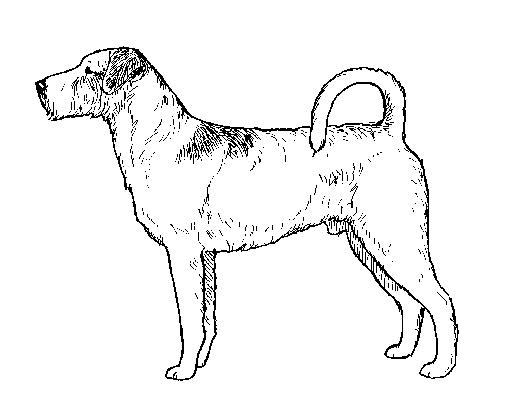Kromfohrlander
Companion Dog Group
The goals and purposes of this breed standard include: to furnish guidelines for breeders who wish to maintain the quality of their breed and to improve it; to advance this breed to a state of similarity throughout the world; and to act as a guide for judges.
Breeders and judges have the responsibility to avoid any conditions or exaggerations that are detrimental to the health, welfare, essence and soundness of this breed, and must take the responsibility to see that these are not perpetuated.
Any departure from the following should be considered a fault, and the seriousness with which the fault should be regarded should be in exact proportion to its degree and its effect upon the health and welfare of the dog and on the dog’s ability to perform its traditional work.
History
The Kromfohrlander is one of the most recent German breeds, internationally recognized only since 1955. The breed is descended from the Wire Fox Terrier and the Grand Griffon Vendeen.
The Kromfohrlander was recognized by the United Kennel Club January 1, 1996. The breed was originally in the Terrier Group, and was moved to the Companion Dog Group on June 1, 2013.
General Appearance
A medium-sized terrier type breed that comes in two coat types, rough and smooth.
Characteristics
An adaptable, docile, and high spirited companion and house dog,. with a moderate hunting instinct. The breed can be somewhat reserved with strangers.
Head
SKULL
The skull is slightly round, with no frontal protuberance. There is a definite frontal furrow and a marked stop.
MUZZLE
The muzzle is the same length as the skull. It has a straight nasal bridge, and the plane of the muzzle is parallel to the plane of the skull. Seen in profile and from above, the muzzle tapers slightly from eyes to nose. The lips are close fitting and not too heavy, with dark pigment. The cheeks have strong musculature.
TEETH
The Kromfohrlander has a complete set of evenly spaced, white teeth meeting in a scissors or level bite.
Disqualifications: Overshot or undershot bite. Absence of more than two molars or three premolars.
NOSE
Medium size, preferably black, but brown is permitted.
EYES
Medium size and oval in shape, set on a slight slant. Dark brown is preferred.
Serious Fault: Light eyes.
Disqualification: Blue eyes.
EARS
Set on high at the sides of the head, the ears are semi drop with the fold not lying above the line of the skull. They are triangular shaped with rounded tips and lie close to the head. The ears are very mobile.
Neck
Medium length, slightly arched and well muscled with no dewlap.
Forequarters
The forequarters are well muscled. The shoulder blade is fairly long and sloping, creating an angle of 110 degrees with the upper arm.
FORELEGS
Straight and vertical. The elbows fit close to the body. The pastern is relatively short and slightly sloping.
Body
The body is slightly longer than tall. The chest is moderately broad and deep to the elbow. The forechest is slightly pronounced, and the ribs are lightly rounded. The back is strong, straight and medium long. The loin is slightly narrower than the ribcage. The croup is slightly sloping. The belly is tucked up.
Hindquarters
The angle at the hip joint is about 100 degrees.
HIND LEGS
The upper thigh is well muscled. The stifle angulation is 105 degrees. The rear pastern is short and vertical.
Feet
Lightly arched, tight toes with well developed, dark pads and strong dark nails. Pale nails are permitted.
Tail
Not docked, medium long, strong at the base and carried saber like over the back.
Coat
There are two types of coat.
Rough coat, which is thick and rough in texture and has a beard. Over the withers and on the back the coat is not longer than three inches. It is shorter on the sides, about one inch. The hair is longer on the face and muzzle. The undercoat is short and soft.
Smooth coat, which is thick and smooth without a beard. The coat is the same length as the rough coat but lies close to the body. The tail has a plume and there is feathering on the backs of the legs. On the face and muzzle, the hair is short and smooth. The undercoat is short and soft.
Color
On the body, the basic color is white, with patches or saddle of tan or light to dark brown. If the undercoat is brown, the tips of the hair may be black. The head has tan or light to dark brown symmetrical markings on the cheeks, ears and above the eyes, divided by a white blaze which reaches up to the forehead or to the nape of the neck without interruption.
Serious Faults: Black shaded patches without brown undercoat. Absence of markings on the body. Distinctly uneven markings on the head.
Height And Weight
Height at the withers is 15 to 18 inches. Weight is from 20 to 35 pounds.
Gait
Flowing and active, with even strides and good reach and drive.
Disqualifications
(A dog with a Disqualification must not be considered for placement in a conformation event, and must be reported to UKC.)
Unilateral or bilateral cryptorchid.
Viciousness or extreme shyness.
Albinism.
Overshot or undershot bite.
Absence of more than two molars or three premolars.
Blue eyes.

Looking for a Dog?
Find a dog that will fit your family.
Note: The breeders on this list are not endorsed by UKC.
Revised June 1, 2013
©Copyright 1996, United Kennel Club
